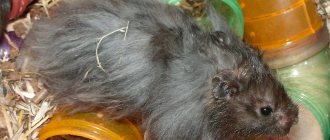Causes of death of a hamster
The lifespan of rodents largely depends on the species to which they belong.
Among the representatives of the Roborovsky breed there are individuals who are 4-4.5 years old. Campbell's babies die 18-20 months after birth.
Old age
If the pet has reached the age of 2 years, the owners need to carefully monitor its behavior. In old age, rodents often die from a stroke, which is accompanied by paralysis of the limbs. Although the hamster is still alive, it is unable to move. In such cases, veterinarians advise euthanizing the pet to save it from additional suffering.
Wrong food
Rodents eat any food offered to them. But some foods lead to the development of diseases:
- snacks (crackers, chips);
- sweets;
- Exotic fruits;
- semi-finished products.
Wrong food leads to the development of diseases.
It is also unacceptable to give your pet spoiled food.
Diseases and injuries
The cause of animal death is often diabetes and obesity. These diseases are caused by poor diet and a tendency to overeat. Rodents are sensitive to low temperatures. If your hamster is frequently bathed or his cage is on a windowsill, the risk of getting sick increases. It is undesirable for the room temperature to be below 20ºC. However, you should not leave the cage near heating devices. This can lead to a stroke.
Trauma is a common cause of death. You can damage internal organs by lightly squeezing your pet's body. Zoologists advise placing the animal in the palm of your hand rather than holding it with your fingers. You should not let your hamster walk on surfaces located high above the floor (tables, bookshelves). The fall ends with a broken spine.
Childbirth
Young females (up to 4 months) die more often during childbirth. A large number of cubs leads to death. The female may die during pregnancy if the offspring died in her womb and the process of decomposition began. The death of the mother and cubs after birth indicates that the individual had diseases.
Sometimes female hamsters die during childbirth.
Stress
Stressful situations are caused by transportation and change of place of residence. For this reason, some hamsters die the day after purchase. To prevent this from happening, the cage is covered with cloth during transportation. In the first 4-7 days after moving, children should be prohibited from playing with the animal. The cage should be in a quiet room.
Hamsters love to stockpile. But since they begin to decompose and emit an unpleasant odor, the owners cleanse the cage of the products hidden in it. Running out of supplies causes severe stress that can lead to death.
The animal owner needs to replace perishable food (fruits, vegetables) with shelf-stable products (biscuits, seeds).
Fright
A pet may die from fright caused by loud noises, bright lights, or the appearance of other pets near the cage. In such cases, adrenaline is released into the blood, which leads to cardiac arrest.
Yearning
In nature, hamsters do not form groups. Even during the mating season, females only need a partner for a few hours. Rodents are unable to experience feelings of loneliness, and melancholy cannot cause their death.
Melancholy can cause the death of hamsters.
After anesthesia
Death occurs after an overdose of anesthesia if the hamster was treated in a veterinary clinic. The animal falls asleep so deeply that it stops breathing and cardiac activity stops.
Other infections
Hamsters can be susceptible to a variety of viral, bacterial, fungal and parasitic infections.
- Hamster polyoma virus (HaPV) causes epizootic lymphoma in young Syrian hamsters and epithelioma in aged enzootically infected hamsters; the latter develop skin tumors.
- Hamster lymphocytic choriomeningitis virus (LMCV) is a zoonotic disease (can be transmitted to humans) that is fatal to small rodents. Symptoms: exhaustion, anorexia, lethargy, weight loss, seizures, blepharitis and hunched posture.
- Bacterial pseudomycetoma requires excision.
- Hamsters infested with mites usually recover after treatment, however failure to respond to treatment indicates an underlying severe illness and often results in death. These major factors include cancer, stress, old age, kidney disease, malnutrition and hyperadrenocorticism.
- Fungal infections in hamsters are rare.
Subtleties of caring for older hamsters
Elderly individuals need special nutrition. The animal's teeth deteriorate. Since the hamster cannot eat dry food, you need to prepare porridge, vegetable and fruit purees for it. It is acceptable to give baby food. Older pets have weakened immune systems. For this reason, cleaning the cage should be done at least 3-4 times a week.
Elderly rodents need peace and privacy. If the cage does not have a house, it must be installed. Pets sleep most of the time. It should be explained to children that the hamster should not be disturbed when it is resting. It is advisable to move the cage to a room facing the shady side.
Stress
Stress is not a disease, but a condition that can dramatically affect your hamster's lifespan by weakening its immune system, leading to illness. The bacterium can be opportunistic in stressed immunocompromised hamsters. Stress can also aggravate pre-existing conditions such as heart disease. It is generally assumed that hamsters that die unexpectedly died from a heart attack or stroke, which can be caused by acute or chronic stress. This may also be a normal age-related death.
How do rodents die?
When the cause of death is old age or illness, the animals die within 3-5 days. If a rodent gets scared and falls from a height, it can die in 2-3 hours or even instantly.
Behavior change
The behavior of a hamster depends on the cause of death. In the early stages of pathologies, the animal may become aggressive and chew the cage. If, after the owner touched the pet, he bit him, this often indicates the presence of pain. The hamster should be taken to a veterinarian.
The hamster's behavior changes; with pathologies, the hamster gnaws at the cage.
In the later stages of diseases and in old age, the rodent becomes passive and does not respond to external stimuli. Pets stop stocking up. The last hours of his life the hamster lies in the corner of the cage. He starts having convulsions. You can tell that a rodent is dying by the groans and wheezes it makes.
External signs
Hair loss is an external sign of impending death in older individuals. Due to muscle weakness, the eyelids droop. There is clouding and sunken eyes. The animal loses its appetite, causing it to lose weight and vitality.
A young but sick individual may also look different from before. An unhealthy hamster has matted fur. Discharge appears from the nose and eyes. Breathing becomes rapid. Coordination deteriorates.
After poisoning or infection, the outward sign of the problem is profuse diarrhea.
How to distinguish from hibernation
Death and hibernation are easy to confuse. Before burying your pet, you need to examine it. The following signs indicate the occurrence of death:
- Lack of breathing. You can hold a mirror to the hamster's nose. If it doesn't fog up, the pet is dead.
- Low temperature. After the heart stops, the body begins to cool down.
- Rigor mortis. If the animal's limbs do not straighten without effort, it has died.
- No heartbeat. You need to place your finger on the pet's chest on the left side. In hibernating hamsters, the heart continues to beat.
- Unpleasant smell. This sign is observed 5-6 hours after death. The smell is caused by the decomposition processes that have begun.
When dying, the hamster has no breathing or heartbeat.
Cancer
- Also called neoplasia, the most common areas for hamsters to develop spontaneous malignancy are the gastrointestinal tract, hematopoietic system, skin area, and appendages. Lymphoma is the most commonly reported cancer of the hematopoietic system. Hamsters with cutaneous lymphoma may experience anorexia, alopecia (patchy hair loss), and weight loss. These symptoms may lead to a misdiagnosis of Cushing's disease.
- Melanomas that occur on the skin are often reported and mainly in male hamsters.
- Djungarian (winter white) hamsters develop neoplasms at a rate 5 times greater than Syrian hamsters, with most tumors being integumentary.
- Cancer is less common in hamsters than in other animals such as rats, poultry, and some strains of mice, but it is still commonly reported and likely goes undetected when hamsters pass away unexpectedly.
What to do when you can’t help a dying person
When the hamster cannot be helped, it is advisable to euthanize it. The procedure is practically painless and costs from 500 to 1000 rubles. Euthanasia should be entrusted to a veterinarian and should not attempt to kill the pet yourself. What to do if owners are hesitant to euthanize an animal:
- Provide complete rest to the dying person. The cage should be moved to a quiet room. The hamster should not be touched unnecessarily.
- Do not try to feed your pet if he refuses to eat.
- Offer your hamster water. The animal is unable to approach the drinking bowl without assistance. The rodent's nose can be moistened with water so that it can lick off the droplets.
How to properly bury a pet
Some cities have pet cemeteries. You can go to a veterinary clinic and use cremation services. Often owners, not knowing how to bury a hamster correctly, bury it in the park. However, dogs can dig up pets in common areas. Such funerals are prohibited by law.
You should not bury hamsters in a summer cottage if the owners grow fruits and vegetables there. When the cause of death is infection, the decaying corpse will poison the soil. The hamster must be buried away from housing, for example, in the forest. Before handling a dead rodent, you should wear gloves. The dead hamster could carry bacteria that are dangerous to human health.
Amyloidosis
This is a disease that can occur spontaneously in old hamsters, and one of the ways hamsters die of "old age." This is due to the accumulation of a substance called amyloid in the organs and occurs in the liver, spleen, kidneys and adrenal glands of aging hamsters.
Weight loss is a common symptom of hepatic (liver) and renal (kidney) amyloidosis.
It is more common and more severe in female hamsters, although it is common in research facilities where overcrowding is a problem, and is much less common in pet hamsters that are kept alone.











